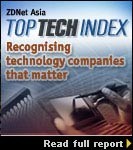HP sharpens blade PC focus in Asia

TOKYO--Hewlett-Packard is betting on its new thin client and blade PC system to push out more applications and services to businesses in more mature IT markets within the Asia-Pacific region.
Known as the Consolidated Client Infrastructure (CCI), the new system has its roots in server-based computing. It is a three-tiered environment made up of thin clients which office workers can use to remotely access corporate applications and data via Microsoft's RDP (Remote Desktop Protocol) from a centrally-managed blade PC system residing in a data center.
Together with a resource tier made up of networked-attached storage (NAS) devices, networked printers and application servers located inside the data center, the blade PC system performs all of the required computing.
HP is touting higher security and lower total cost of ownership with the CCI compared to traditional client-server environments.
Speaking to reporters at a media conference in Japan, Wong Shing Wai, product marketing manager of HP's business PC division for Asia-Pacific and Japan, explained: "Data is secure with the CCI environment. Even if hackers can sniff out the communication network (between the access device and the data center), data will never leave the data center." The only data that hackers will be able to capture are mouse-clicks and image transfers, he added.
Wong claimed that businesses can expect a low total cost of ownership from the CCI infrastructure because it reduces power consumption as well as the need for PC and helpdesk support, and improves software tracking and compliance, among other benefits.
The CCI is suited for larger organizations with 500 users and above, he said. He also revealed that a customer in Singapore has expressed interest in testing the CCI.
According to Joergen Jakobsen, vice president of HP's business PC group for Asia Pacific and Japan, the CCI was introduced in North America more than a year ago. The system was launched in Japan in June this year, followed by Australia in early November.
HP has no concrete plans to launch the CCI in other Asian markets yet, but ZDNet Asia understands that the PC maker is considering more IT sophisticated markets such as Singapore and Hong Kong. And the plan is to roll out the CCI in phases in 2006.
On why HP has chosen a phased rollout plan, Jakobsen explained: "That's because of the CCI's selling cycle. Its implementation requires a high level of commitment (from HP). We will not go [into a market] unless we are confident we have sales people equipped with the right skills for solution selling and consulting, and change management."
In the PC blade market, HP faces competition from Austin, Texas-based ClearCube and Carson City, NV-based Cubix. IBM is currently using ClearCube to offer its customers blade PC technology.
The sales cycle for the CCI typically begins with a pilot on a customer's site to validate profiles and business processes. This could last up to two months, and require an average US$50,000 investment, depending on the scale of the deployment, said Wong.
Lilian Tay, a systems analyst with Gartner Asia-Pacific, said it is not unusual for a vendor to take such precautions, considering the long sales cycle required to sell the CCI. "It is correct for them to be very selective in the countries where they're making (the CCI) available," she said, pointing out that labor is a major component of the CCI costs.
"The security part is a very easy sell…it is a very easy feature to understand. But what's important is also the second part, which is the total cost of ownership. In any TCO calculation, salary is a major component. In India and China, TCO costs calculation (of the CCI) will not be so appealing compared to matured countries where labor costs are higher," she said.
HP is confident businesses will see the CCI's value proposition. Jakobsen said he expects CCI sales to make up 10 percent of HP's business PC portfolio in the Asia-Pacific, including Japan, "by the end of the decade".
Jeanne Lim reported from Tokyo, Japan.
